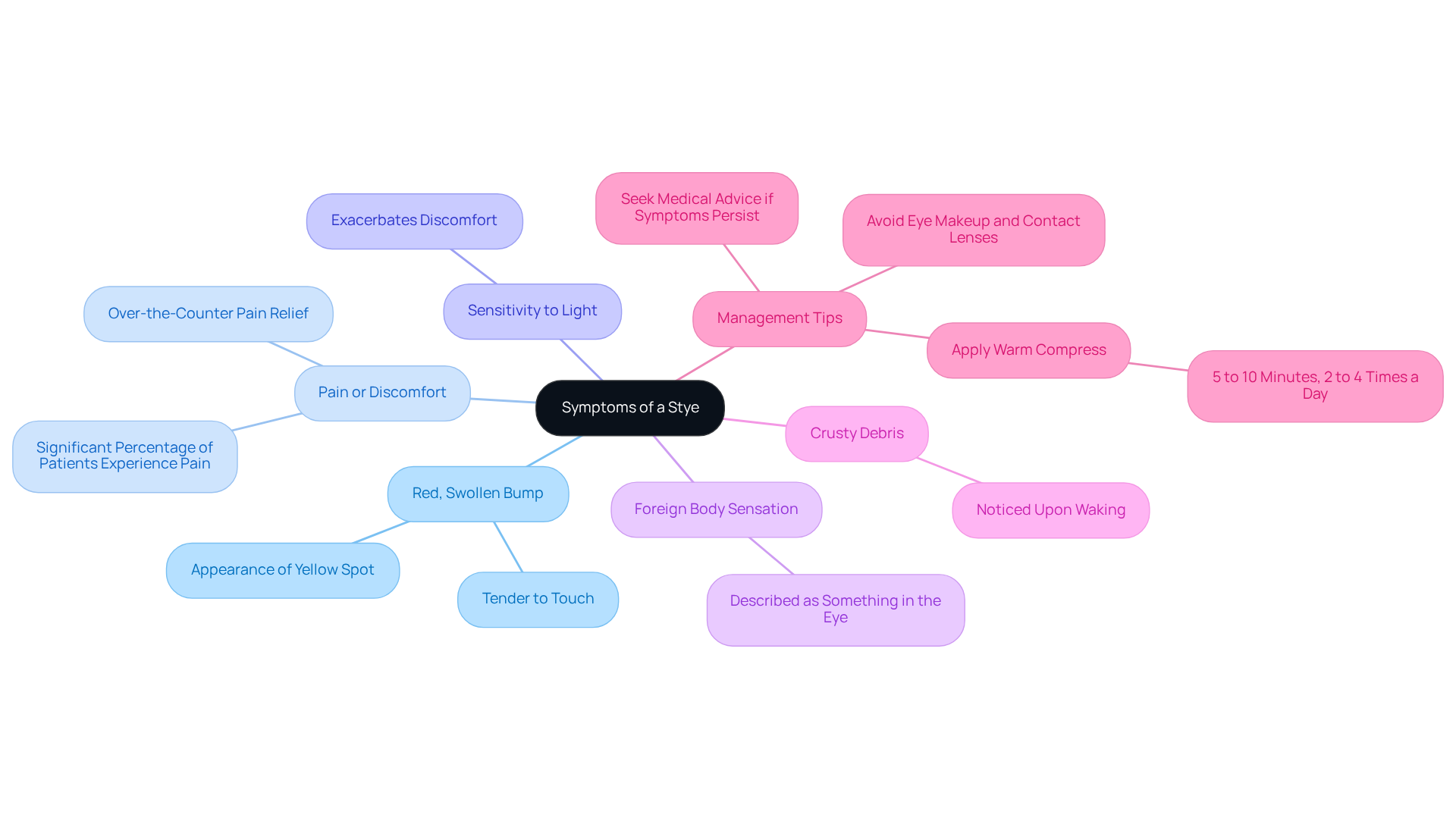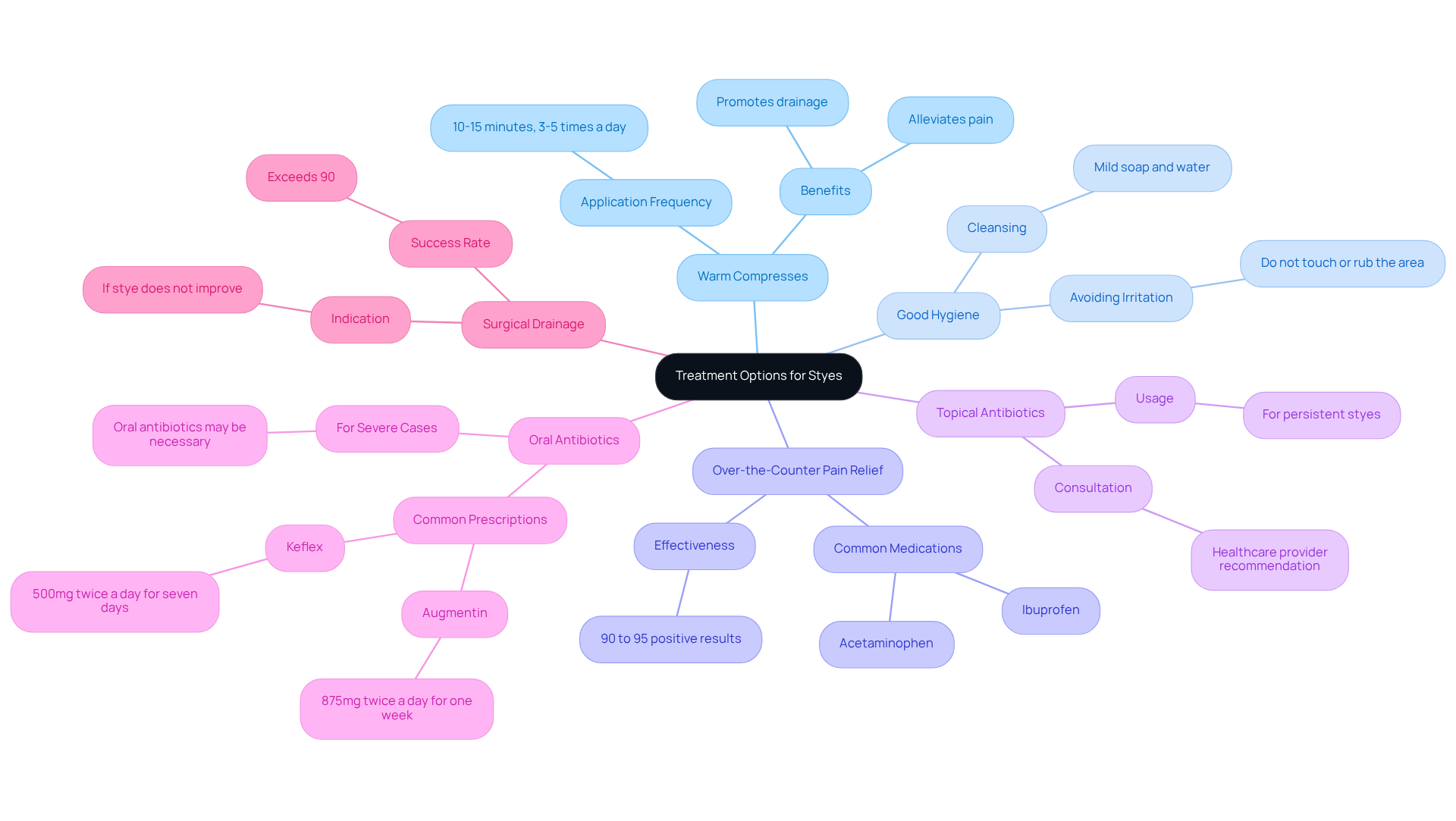Posted by: Northwest Eye in General on June 21, 2025
Overview
A stye is generally not contagious, which can be reassuring to those concerned about its spread. It represents a localized infection of the oil glands in the eyelids. However, it’s important to note that the bacteria causing a stye can be transmitted through direct contact. We understand that this might raise questions about hygiene and safety.
Maintaining good hygiene practices is crucial in preventing the transmission of the bacteria responsible for eye infections. Simple actions, such as:
- Washing your hands regularly
- Avoiding the sharing of personal items
can make a significant difference. Remember, while styes themselves do not spread, taking these precautions helps protect your eye health and gives you peace of mind.
Introduction
A hordeolum, commonly known as a stye, is more than just an unsightly bump on the eyelid; it represents a localized infection that can cause discomfort and concern. We understand that dealing with a stye can be worrying, and knowing the symptoms and treatment options is crucial for effective management.
It’s common to feel anxious about contagion, but understanding the facts can help alleviate those worries. While many may wonder if styes can be passed from person to person, the reality is more nuanced. This leads us to an important question: how can one effectively prevent the spread of bacteria while managing this common eye condition? We are here to help you through this process.
Understand What a Stye Is
A , commonly known as a stye, can be quite uncomfortable, appearing as a . This occurs due to an , often caused by Staphylococcus aureus bacteria. Styes can develop externally on or internally within the eyelid itself. Typically filled with pus, they may look like a pimple and can lead to discomfort, light sensitivity, tearing, and irritation, including redness and itchiness.
It’s common to feel concerned about styes, especially since they are notably prevalent among adults. This is often due to thicker oil in their glands, making them more prone to blockage. While these eyelid bumps are generally harmless and usually resolve on their own within one to two weeks, we understand that they can be painful until they do.
It’s important to recognize that untreated , such as abscesses or cellulitis. Symptoms like redness, soreness, and itchiness can also indicate other conditions, such as or , which may require professional medical attention.
If , like applying a warm washcloth for 10 to 15 minutes, three to five times a day, do not alleviate symptoms after 48 hours, seeking medical attention may be necessary. We encourage you to prioritize to avoid infections, as bacteria can transmit through direct contact, and while a stye is contagious, these infections are not highly contagious.
Understanding the characteristics and , along with other potential causes of eye discomfort, is vital for effective management and prompt care. Remember, we are here to help you through this process.

Recognize the Symptoms of a Stye
Common symptoms of a stye can be concerning, and we understand how they might make you feel uneasy. These include:
- A , often tender to the touch.
- Pain or discomfort in the affected area, with studies indicating that a significant percentage of patients experience pain.
- Increased sensitivity to light, which can exacerbate discomfort.
- A , often described as a foreign body sensation.
- , particularly noticeable upon waking.
resolve by themselves in 1 to 2 weeks, which can provide comfort as you navigate this condition. Applying a for 5 to 10 minutes, 2 to 4 times per day can help alleviate symptoms and ease discomfort. It’s important to recognize that these eye bumps, which raise the question of whether a stye is contagious, are not contagious, which may help ease your worries. We recommend refraining from eye makeup and contact lenses until your eye condition has healed.
Recognizing these symptoms early is crucial for effective management. If an continues for more than one to two weeks or worsens, we encourage you to to explore additional treatment options. Remember, we are here to help you through this process.

Explore Treatment Options for Styes
typically involves several key strategies that can help you feel more comfortable and supported during this time:
- : We recommend applying a warm, damp washcloth to the affected area of your eye for 10-15 minutes, 3-5 times a day. This method not only alleviates pain but also promotes drainage, significantly speeding up your recovery.
- : Keeping the area around your eyes clean is crucial. Gently cleanse your eyelid with mild soap and water, and remember to avoid touching or rubbing the affected area to prevent further irritation.
- : Non-prescription pain relievers, such as ibuprofen or acetaminophen, can effectively related to eyelid infections. It’s common to find relief using these medications, with statistics indicating that 90% to 95% of patients experience positive results.
- : If your stye continues for more than a few days, a healthcare provider may suggest antibiotic ointments or drops to address the issue, reassuring you that help is available.
- Oral Antibiotics: In instances of , oral antibiotics may be necessary. For instance, Augmentin is often prescribed at 875mg twice a day for one week for more serious infections, highlighting the importance of .
- : If a chalazion does not improve with conservative treatment, surgical drainage may be required. This procedure is typically performed under local anesthesia and has a success rate exceeding 90%, with most patients experiencing significant relief afterward.
Most eyelid bumps clear up naturally within a week, but by following these treatment choices, you can and reduce discomfort. We understand that managing symptoms can be challenging, but by adhering to these guidelines, you can effectively promote faster healing and feel supported throughout the process.

Determine If a Stye Is Contagious
It is important to note that while many wonder if a stye is contagious, they are typically not contagious and represent localized infections of the oil glands in the eyelids. However, we understand that concerns about can be worrying. It’s important to know that while , the can be transmitted through direct contact. For instance, touching an eye infection and then another person’s eye can promote the spread of bacteria. To effectively minimize this risk, consider the following :
- Always wash your hands thoroughly before and after .
- Avoid sharing personal items such as towels, pillowcases, or makeup, as these can harbor bacteria.
- If you have a , it is wise to avoid using eye cosmetics until the ailment has completely recovered.
As James Roland, an eye care professional, states, ‘While styes are not contagious, it is a stye contagious as they represent a local infection or inflammation of the oil-producing glands of the eyelids.’ By adhering to these hygiene practices, you can significantly reduce the likelihood of bacterial transmission and promote faster healing. We encourage you to consistently wash your hands and maintain hygiene around your eyes, as these are essential measures in and promoting . Additionally, applying a several times a day can help alleviate discomfort and promote healing, as styes typically resolve within 3 to 5 days. If symptoms persist or worsen, it’s common to feel concerned, so it is important to for further evaluation. We are here to help you through this process.

Conclusion
Understanding the nature of styes is crucial for managing this common eye condition effectively. We understand that they can be uncomfortable and concerning, but it is important to remember that styes are typically localized infections and are not contagious in the traditional sense. The bacteria responsible for styes may spread through direct contact, yet with proper hygiene and care, the risk of transmission can be minimized.
Throughout this guide, we have discussed key insights, including:
- The symptoms of styes
- Effective treatment options
- Preventive measures to reduce the risk of infection
From applying warm compresses to maintaining good eyelash hygiene, these strategies can significantly alleviate discomfort and promote healing. It’s common to feel uncertain about when to seek medical advice, particularly if symptoms persist or worsen.
Ultimately, maintaining awareness and practicing good hygiene are essential steps in managing styes and promoting overall eye health. By taking proactive measures and understanding the nature of this condition, you can navigate the discomfort of styes with confidence and reduce the likelihood of recurrence. Prioritizing eye care not only enhances your well-being but also contributes to a healthier environment for all. We are here to help you through this process.
Frequently Asked Questions
What is a stye?
A stye, or hordeolum, is a painful, red bump on the edge of the eye caused by an infection of an oil gland, often due to Staphylococcus aureus bacteria.
Where can styes develop?
Styes can develop externally on the outer eyelid or internally within the eyelid itself.
What symptoms are associated with a stye?
Symptoms of a stye include discomfort, light sensitivity, tearing, irritation, redness, and itchiness.
Are styes common, and who is more prone to them?
Styes are common, particularly among adults, as they often have thicker oil in their glands, making them more susceptible to blockage.
How long do styes usually last?
Styes are generally harmless and typically resolve on their own within one to two weeks.
What complications can arise from untreated styes?
Untreated styes can lead to more serious complications, such as abscesses or cellulitis.
When should I seek medical attention for a stye?
If self-care measures, such as applying a warm washcloth, do not alleviate symptoms after 48 hours, it may be necessary to seek medical attention.
How can I prevent styes?
Proper eyelash hygiene is important to avoid infections, as bacteria can transmit through direct contact.
Are styes contagious?
While a stye is contagious, these infections are not highly contagious.
What other conditions can symptoms of a stye indicate?
Symptoms like redness, soreness, and itchiness can also indicate other conditions, such as conjunctivitis or dry eye disease, which may require professional medical attention.






